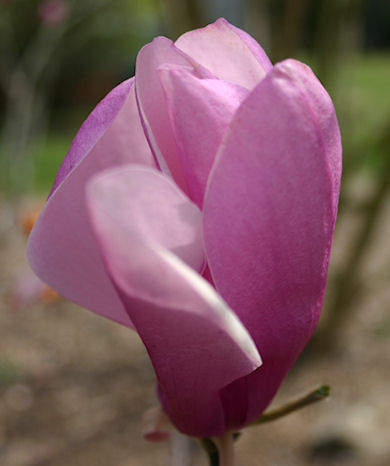JANUARY
Schedule a free consultation with OIM for your yard's spring landscape or hardscape project. 10% discount on plants and shrubs when you sign-on with OIM's landscape maintenance package by January 30th.
FEBRUARY
WHAT’S BLOOMING:
Crocus, Pansies, Primrose, Early Daffodils, Lenten Rose, Camellia Japonica, Winter Sweet, Winter Honeysuckle, Winter Jasmine, Mahonia, Forsythia, Flowering Quince and Bridal Wreath Spirea.
PLANTING:
Continue planting balled and bur lapped trees and shrubs.
Continue transplanting.
Roses will be arriving at most garden centers mid-month.
Plant berries and brambles now. Also Asparagus and Rhubarb.
Prepare the soil for vegetable gardens. If dry, have soil tested.
CHEMICALS:
Spray dormant oil products, especially on roses and fruits trees.
Read the label carefully.
Apply crabgrass pre-emergent to lawns. A general guideline is to apply when Forsythia is blooming warm & cool season turf.
Apply pre-emergent to shrub beds.
GENERAL:
Adjust your lawn mower to highest setting then mow Mondo Grass and Liriope.
Delay most pruning until cold is past, except for dead wood and deciduous trees. Do not prune conifer.
MARCH
WHAT’S BLOOMING:
Daffodils, Tulips, Anemones, Pansies, Hyacinth, Thrift, Candytuft, Deciduous Azaleas, Bridal Wreath Spirea, Forsythia, Quince, Pieris, Japanese Magnolias, Crabapples, Red Maple, Cherries, Pears, Plums, Redbuds and Amelanchier.
PLANTING:
March is prime planting time for trees, shrubs, roses, and perennials.
Prepare beds as soon as weather dries out.
Divide and transplant summer and fall flowering perennials.
Plant vegetables according to soil temperature.
March is not safe for planting annuals.
CHEMICALS:
Fertilize existing trees and shrubs.
Fertilize bulbs after blooming.
Apply Pre-emergent if you have not done so.
Spray contact herbicide on Poison Ivy and Honeysuckle when green leaves appears.
Begin spraying roses with fungicide and systemic insect control along with proper nutrient feeding.
Check Camellias, Gardenias and Hollies for scale insects under leaves.
Spray with Volck Oil if needed.
GENERAL:
Fescue clippings can be left in the lawn while weather is cool. This returns organic matter to the soil.
Water new plantings.
Prune ground covers and spring flowering shrubs after they bloom.
APRIL
WHAT’S BLOOMING:
Hyacinth, Late Tulips, Iris, Creeping Phlox, Garden Pink, Scilla, Columbine, Pansies, Evergreen Candytuft, Wisteria, Carolina Jessamine, Periwinkle, Azaleas, Rhododendron, Mountain Laurel, Deutzia, Kerria, Lilac, Mock Orange, Photina, Scotch Broom, Spirea, Sweet Shrub, Weigela, Dogwood, Cherries, Fringe Tree, Silver bell, Hawthorne and Flowering Peach.
PLANTING:
Continue planting trees, shrubs, roses, perennials and ground covers.
Begin planting annuals, summer vegetables and herbs after danger of frost is past, typically the last part of April.
Plant Dahlias, Cannas, Caladiums, Tuberose and other tender bulbs.
Transplant unknown varieties of Azaleas while in bloom to assure proper color combination.
Stake vegetables and flowers when planted to avoid root damage later.
CHEMICALS:
Fertilize evergreen shrubs if you have not done so.
Fertilize roses and annuals.
Fertilize and dethatch Bermuda (May/June is better to dethatch), Zoysia and Centipede lawns when they begin to turn green.
Spray Azaleas, Cotoneaster and Pyracantha for lace. Check for dark spots under leaves and be sure to spray underneath.
GENERAL:
Begin weed control program. Be sure you have 3" of mulch in beds and pull weeds while they are small.
Water during dry spells.
Add interest to paved areas with containers of colorful plants. Be sure to consider the color of surrounding surfaces when purchasing containers and flowers.
MAY
WHAT’S BLOOMING:
Pansies, Thrift, Evergreen Candytuft, Columbine, Iris, Bleeding Heart, Peonies, Garden Pinks, Sweet William, Lilies, Phloxdivaricata, Foxglove, Campanula, some Roses, Ajuga, Azaleas, Rhododendron, Florida Jasmine, Mountain Laurel, Spirea, Cucumber, Magnolia and a full array of annuals.
PLANTING:
Continue planting containers plants and annuals.
Repair worn spots in warm season sodded lawns.
Sew Seeds outside.
Plant perennials.
CHEMICALS:
Fertilize, mulch and prune Azaleas after blooming.
Fertilize evergreens and warm season lawns if you have not done so.
Check Azaleas, Rhododendrons, Hydrangea and Magnolia for yellow leaves with green veins. Treat foliage with iron chelate, and have the soil tested.
Apply moisture manager to cool season turf "Full Sun Areas".
GENERAL:
Prune dead wood off evergreens.
Continue weed control while weeds are young.
Water during dry spells.
JUNE
WHAT’S BLOOMING:
Astilbe, Crinum Lilies, Daylilies, Garden Pinks, Hollyhocks, Shasta Daisy, Roses, Veronica, Snadragon, Aaronsbeard St. Johnswort, Clematis, Confederate Jasmine, Satsuki Azaleas, Spirea 'Anthony Waterer', Gardenia, Oakleaf Hydrangea, House Hydrangea, Mimosa and Golden Rain Tree.
PLANTING:
Continue to plant container shrubs, perennials, annuals and herbs.
Install Bermuda, Zoysia and Centipede Sod. Also seed Bermuda and Centipede.
CHEMICALS:
Check Crape Myrtles for powdery mildew, a pale dust over all the plant. Spray with a fungicide.
Spray Redtips and Roses for black spot.
Fertilize plants and lawn, and water well.
Brown Patch season begins, (Tool: add current days humidly (+) current days high temp = 160=Brown Patch)
GENERAL:
Consider starting a compost pile using grass clippings. This is preferable to putting directly in beds.
Cut Petunias back several inches after first blooming flush, to revitalize in hot weather. Water during dry spells.
JULY
WHAT’S BLOOMING:
Coreopsis, Butterfly Weed, Gaillardia, Gerber Daisy, Gladiolus, Daisies, Helianthus, Blackeyed Susan, Hosta, Lilies, Balloon Flower, Lantana, St John's wort, Trumpet Vine, Tuberose, Stokesia, Hydrangea, Roses, Butterfly Bush, Gardenia, Rose of Sharon, Hibiscus, Mimosa, Magnolia, Chaste Tree, Crape Myrtle and an array of annuals.
PLANTING:
Divide and transplant bearded Iris.
Continue Planting perennials and annuals.
Continue installing warm season grasses.
CHEMICALS:
Fertilize perennials, vegetables and shrubs.
Fertilize and water annuals.
Check for sooty mold on Crape Myrtles. This black soot, like fungus, is a by-product of aphid infestation. Spray with an insecticide for aphids.
GENERAL:
Mulch all beds well.
Edge lawn long drives and walks.
Pinch back mums.
Water.
AUGUST
WHAT’S BLOOMING:
Garden Phlox, Coreopsis, Stokeasia, Sunflowers, Tansy, Gladiolus, Daylilies, Blackeyed Susan, Trumpet Vine, Liriope, Pampas Grass, Fountain Grass, Eulalia Grass, Rose of Sharon, Hibiscus, Abelia, Roses, Crape Myrtle and a full array of annuals.
PLANTING:
In Late May through Mid July.
WATERING:
Sufficient watering is a critical factor for maintaining your plants for the first 12-18 months.
Supplemental water is absolutely necessary during Spring and Summer or during dry weather at any time. Particularly important is the period in late winter and early spring when plants must have sufficient water for new growth to begin.
A slow deep watering is essential, rather than several quick applications. Water once a week, (normally 30 minutes to one hour per tree), in hot weather, unless there is at least one inch of rainfall each week to 10 days. You may want to check the soil moisture about one foot down (at outside of the hole to avoid root damage) to make sure you are watering enough, but not too much. Deep infrequent watering on turf and plants.
GENERAL:
Pull weeds before they set seed.
Prune weak growth on roses for a better fall crop, and continue spraying program.
Broad weed clean up on turf.
SEPTEMBER
WHAT’S BLOOMING:
Dahlia, Delphinium, Gladiolus, Abelia, Roses, Elaeagnus, Heliopsis, Sweet Autumn Clematis, Franklin Tree and many annuals.
PLANTING:
Purchase bulbs for the best selection as soon as they arrive in garden centers. Delay planting and store in refrigerator.
Plant Pansies and Chrysanthemums.
Install warm season sod before first frost.
Plant container grown shrubs and ground covers.
CHEMICALS:
Fertilize cool season grasses, such as Fescues, as soon as weather cools.
Starter Fertilize. Have soil tested, and apply lime if indicated.
Fertilize existing plants with nitrogen fertilizer.
GENERAL:
Aerate and reseed Fescue towards end of month.
OCTOBER
WHAT’S BLOOMING:
Chrysanthemums, Spider Lily, Dahlias, Pansies, Goldenrod (which does not cause hay fever), Osmanthus, Elaeagnus, Camellia Sasanqua. Annuals will continue blooming if they were well maintained all summer.
FALL COLOR:
Maples, Dogwoods, Sourwood, Gingko, Zelkova, Burning Bush, Euonymus Coloratus and Oakleaf Hydrangea.
PLANTING:
Plant Chrysanthemums and winter vegetables.
Divide and transplant overcrowded perennials.
Plant Shrubs and ground covers.
Prepare new beds while the weather is good.
Transplant shrubs during fall and winter.
Time to overseed Bermuda grass Mid October.
GENERAL:
Replenish pine straw in beds.
Prepare roses for winter by raking up leaves and old mulch.
Discard leaves of Camellia Sasanqua which are infested with leaf gall.
This appears as swollen, misshapen growth.
Fertilize, aerate, lime and re-seed Fescue lawns.
Apply winter fertilize 4 to 6 weeks after aeration.
NOVEMBER
WHAT’S BLOOMING:
Chrysanthemum, Cosmos, some Roses, Pansies, Camellia Japonica and Camellia Sasanqua. Berries: Aucuba, Dogwood, Euonymous, Nandina, Pyracantha and Hollies.
FALL COLOR:
Oaks, Hickories, Bradford Pear, Euonymous, Viburnums and Virginia Creeper.
PLANTING:
Buy and plant trees now, for best selection.
Plant Spring blooming bulbs.
Wrap the trunks of new trees.
Prepare planting beds if soil is not too wet.
Dig up Dahlias, Cannas, Caladiums, Tuberoses, and Gladiolus as soon as the foliage turns brown.
GENERAL:
Rake leaves before the mat down. Store for compost later.
Mulch beds well before winter.
Continue renovation on Fescue lawns.
Pull out annuals and cut brown perennials.
Prune roses and mulch well.
Winterize sprinkler systems.
DECEMBER
WHAT’S BLOOMING:
Pansies, Camellia Japonica and Christmas Rose.
Berries: Hollies, cotoneaster, Pyracantha and Nandina (Red-Purple leaves). Dwarf Japanese Garden Juniper, Blue Pacific Juniper and Evergreen Garden Pinks.
Attractive Bark: Crape Myrtle, River Birch, Heritage White Birch, American Beech and Sycamore.
Plants which provide food for birds: Chinese, Japanese and American Hollies, Beautybush, Cherry Laurel, Dogwoods, Amelanchier, Euonymous, Vibaurnums, Hawthorne, Pyracantha, Elaeagnus, Sumac and many annuals and perennials if seedheads are not removed, especially those in the Daisy family.
PLANTING:
Continue planting all trees, hardy shrubs and spring bulbs. Transplant shrubs and trees.
Apply 21-0-00 (Ammonia Sulfate fertilizer) on cool season turf to keep green.
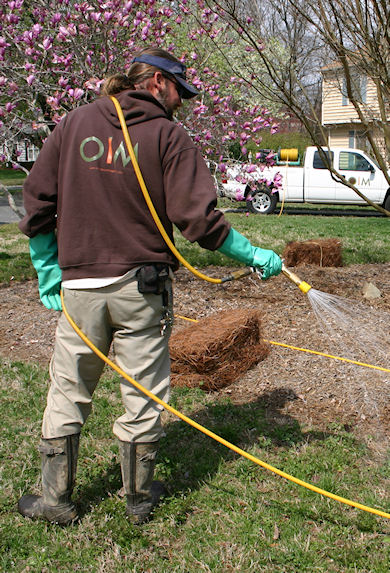

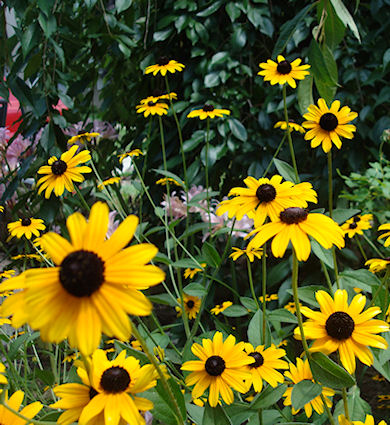
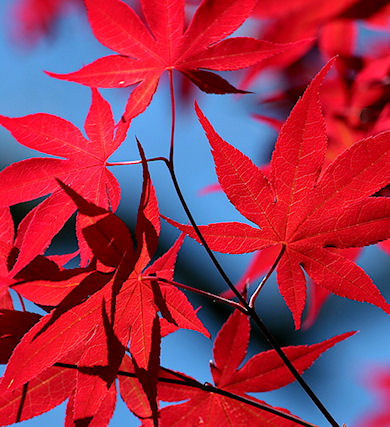
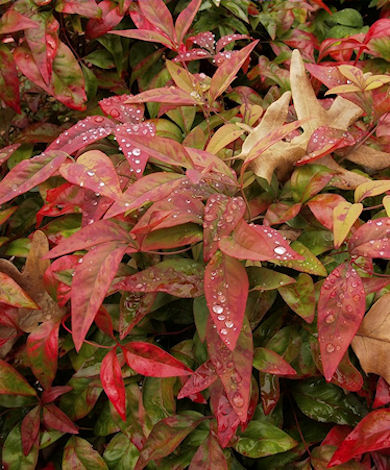
| COMMERCIAL | | | CUSTOM LANDSCAPING | | | IRRIGATION | | | HARDSCAPING | | | OUTDOOR LIGHTING | | | PONDS & WATERFALLS | | | BEFORE & AFTERS |

